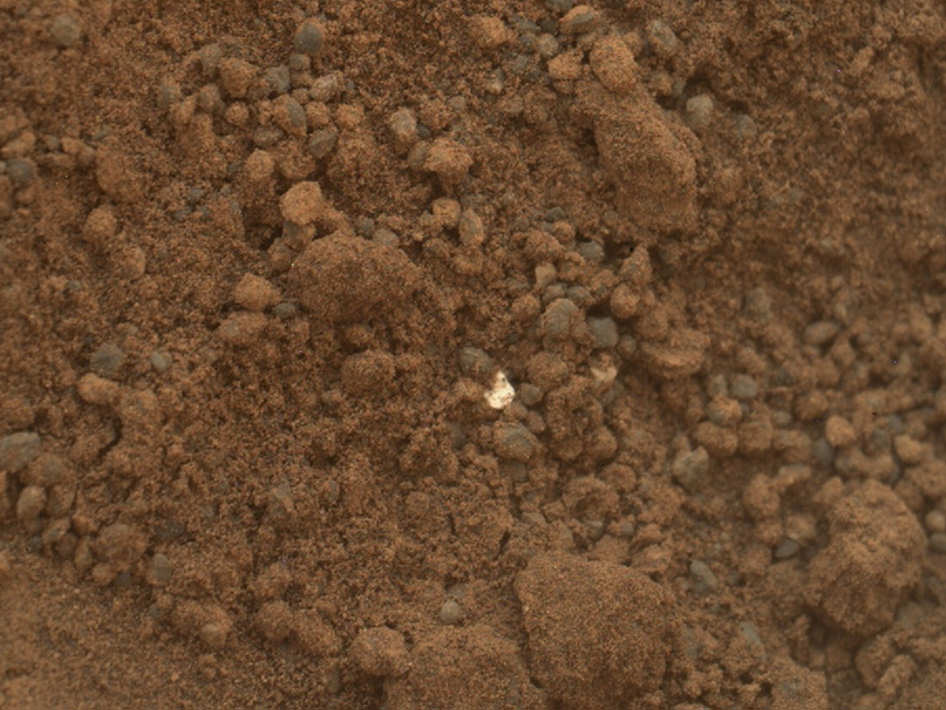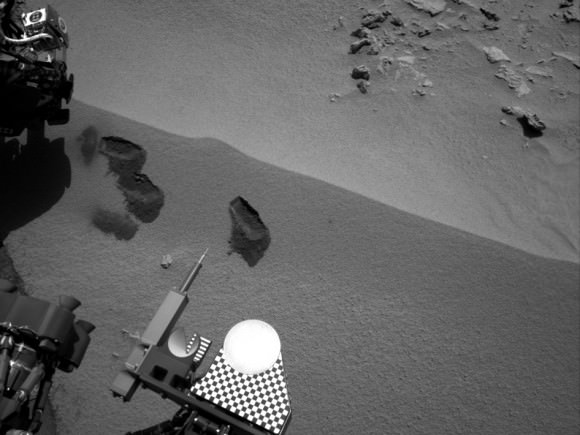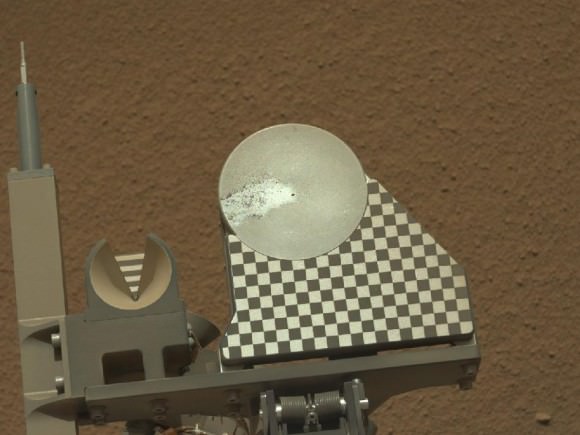A bright particle found inside a scoop hole created by the Curiosity rover. Credit: NASA/JPL-Caltech.
Last weekend, the Mars Curiosity rover scooped out a few “bites” in the small, sandy dune known as Rocknest and inside the second scoop hole was a small, shiny particle, as we reported earlier. This speck – and others like it in the pit — is different than the previous object that looked like plastic and may have come from the rover itself. After some analysis, the MSL science team thinks the shiny particle is just part of the soil on Mars.
“As the science team thought about it more and more, the bright object is about the same size as the granules that it’s in and it is not uniformly bright,” said John Grotziner, MSL project scientist. “We went back and forth, and the majority of the science team thinks this is indigenous to Mars.”
And so, Grotziner said, these shiny objects likely represent a science opportunity rather than an engineering hazard.
One hypothesis that the specks are natural geologic material that might have a broken-off, flat surface called a cleavage that could be reflecting sunlight, making it appear bright.
The size of the bright fleck is about 1 mm, so it is “pretty representative of other objects there,” Grotzinger said, which range from half a millimeter to 2 millimeters.
Grotzinger said they will use the ChemCam instrument to take a closer look at the shiny specks. “We are going to shoot it with ChemCam, a remote sensing tool that has spectacular spatial resolution,” he said, “and aim it right on that fleck. Then we’ll aim it on another darker grain and try to decide if it is a different class of mineral.”
Three ‘bite marks’ left in the Martian ground by the scoop on the robotic arm the Curiosity rover are visible in this image taken by the rover’s right Navigation Camera during the mission’s 69th Martian day, or sol (Oct. 15, 2012). Credit: NASA/JPL-Caltech
One way the team tested if the shiny flecks were something that may have come from the rover was that after pictures were taken of the area, they vibrated the rover for about an hour and then took more images. Nothing had changed in the surrounding area, with no additional flecks visible on the ground.
After the shiny fleck was initially seen, the team dumped out the scoop they had taken over concerns it was another foreign object, perhaps from the rover or from the Entry Descent and Landing of the rover, as was determined for previous, plastic-looking object found on Mars. But now they are planning to look closer at both the dumped-out scoop of soil and the pit to analyze the shiny flecks.
The big news that Grotzinger reported today during a press briefing was that they just received confirmation that the rover successfully placed a small sample of soil inside Chemistry and Mineralogy (CheMin) instrument and soon will be analyzing the sample to determine what minerals it contains.
“Our mobile laboratory eats dirt,” Grotzinger said, “whether we scoop it up or drill a hole in rock, that’s what keeps us going, that’s what we live on.”
They also placed a portion of the third scoop of soil taken onto the observation tray and took an image of it with the Mastcam.
“We see two components in the soil,” Grotzinger said. “One is a thin layer of lighter colored, finer grained material. Then there are some darker grains, which represent the courser fraction that is available.”
A closeup look at the sample of Martian regolith that was dumped on an observation tray on the rover. The tray is 7.8 centimeters (3 inches) in diameter. Credit: NASA/JPL-Caltech
Grotzinger said he hopes to be able to report within the week of the results of the first analysis of Martian soil from CheMin. Also, the SAM laboratory (Sample Analysis at Mars) is scheduled to take its first sample next week. SAM is a suite of instruments that investigate the past and present ability of Mars to support life.
They were slowed in slightly in getting the first sample inside ChemMin not only by the discovery of the bright flecks, but also by a safing event that took place on the Mars Reconnaissance Orbiter, which relays the data from the rover to Earth. The orbiter is now back to full functionality.
NASA’s latest report about the rover can be read here.




It’s Gold…..Martian Gold!
Well… diamonds form from meteor impacts… and this is quite a big crater after all… 🙂
how come the sand looks wet?
how come the sands looks wet from the first photo?
Because there are no bathrooms on Mars… yet.
Industrial debris left over from the Martian Civilization Collapse, obviously.
I like shinies.
Definitively a “Martian”, no questions about it…small, but martian…or…pieces from the rover after impacted the surface of Mars…
It was established the terrain used to be a riverbed of sort. Those shiny things could be shells…
If only!
We should not be suprized that somthing shiny exists. Let’s hope we can figure out what it is. 10 weeks into a 2 year mission. That’s 10% complete. No more vibration stress testing this is the real deal now.
It must be spice… only explanation…
Report from Martian Inteligence Agency on the new Extra-Terrestrial that has landed on Mars.
Observation #74: Spends large amounts of time stairing at shiny objects, indicating limited itelligence.
Oh, shiny!
http://tvtropes.org/pmwiki/pmwiki.php/Main/AttentionDeficitOohShiny
(In case you have too much time at your hand…)
LOL! Nice one!
Martian WMD. Now we have to bomb them as well because Saddam might be hiding under the ground.
This mission is friggin excellent.
They vibrated the rover for an hour? I didn’t know it could do that!
Commander Chekov, target the bright object with the LASER and fire at will.
It is all a cover up just to hide NASA’s caught-out incompetence.
The moronic incompetence of trolls. however, can’t be hidden by any size shiny object. That was the worst trolling attempt this whole year. :-/
..it was intended as a joke, you know! (Look at the other inane comments here)
Unfortunately, your jokes ring hollow as a consequence of your incessant America/NASA bashing. Time to take up another cause, me thinks.
When I need you advice, I’ll ask for it.
Also pro-American sites like this one show the usual bias. Someone has to bring you guys down a peg or two and break this rather insular world-view. The obvious anti-Chinese bias here, for example, is absolutely culpable.
America is a good country with lot of good people, and no one can deny that. However, it is not the only country, and is also not infallible nor exempt from justifiable and necessary criticism. It is perhaps a reality check some ‘blind’ Americans should comprehend — especially related to superiority complexes and the damage being currently levelled at the global economy.
Disagree you may, but don’t come at me just because you don’t like it. Virtues of free speech from what you say here only exposes you as a wanton hypocrite.
I could get all mean and nasty, but why bother. Instead I so pity you, brother. I really do.
So you elect yourself as the judge and jury to come to a friendly space-news-based community and piss all over our happy interactions, so as to accomplish…..? Making yourself feel more important than you know you are….? showing off how politically aware you are……? to simply get small doses of power-trip rush…….? Whatever silly little reason, it rings pathetic and hollow to anyone else bearing witness.
…just another filthy hypocrite. I wasn’t even replying to you, so may I suggest you MYOB!
It’s my community as well. This is a thread. You know how forums work, right? No? You seem to troll enough in them one would think by now you’d have sussed how/when/why people reply and comment. There’s a rythm to it. Try real hard to pick up on that. And calling someone a hypocrite usually requires that person being hypocritical about something. To my knowledge I haven’t contradicted my views at all. Make sense… or better yet, please just leave us all alone, child
Enough. Get this. I don’t care what you say nor what you think.
Comment on the stories and please stop fracken’ attacking me!!!!!!!
Eh? Speak about suppression of free speech and you become “judge and jury”? It seems twits like you think it is perfectly OK to “Time to take up another cause” or want you to ‘disappear’ because they disagree with your own self-deluded form of righteousness? That is what I said was hypocritical and made you a “filthy hypocrite.”
Comprehension clearly isn’t your strong suit!
@SJStar:disqus : The Chinese haven’t really done much yet apart from sending a probe to the moon and blasting out the “Long March” onto the moon. Talk about jingoism , as if anyone is around to listen to the “Long March” on the moon!
China is the future. America is the past. It’s that simple.
I was wondering whether the first bit might be a bit of mica or something similar. You get chips of mica in alluvial deposits on Earth. Small, thin chips might well get blown about and end up sitting on the surface like that.
I’ll wager we’ll see more and more of these ‘shiny’ particles as Curiosity climbs higher into the hills. Mmmm… could be they remnants of meteor impact shock differentiation, similar to the shocked quartz or other terrestrial impact artifacts?
Each of the squares in the checkerboard pattern are exactly 1/4″ square. Useful…
Looking closer it could indeed be gold. It is indeed in a watery area. This could be evidence that no intelligent life has ever existed on Mars. Humanity or Maranity would have picked up little shiny objects and amassed them together buring them in caches to never be seen again.
Could be quartz or silica, pity it’s not gold as that would give a boost for private investment.
Oh crap, somebody build me a space ship. I’m gonna go prospecting on mars!
This was made for Mars eyed folks like you –
Elton John – Rocket Man